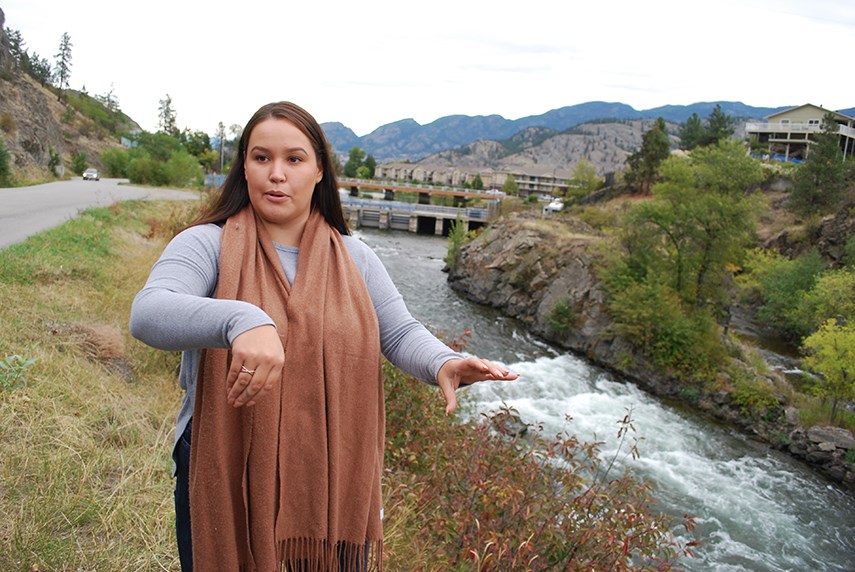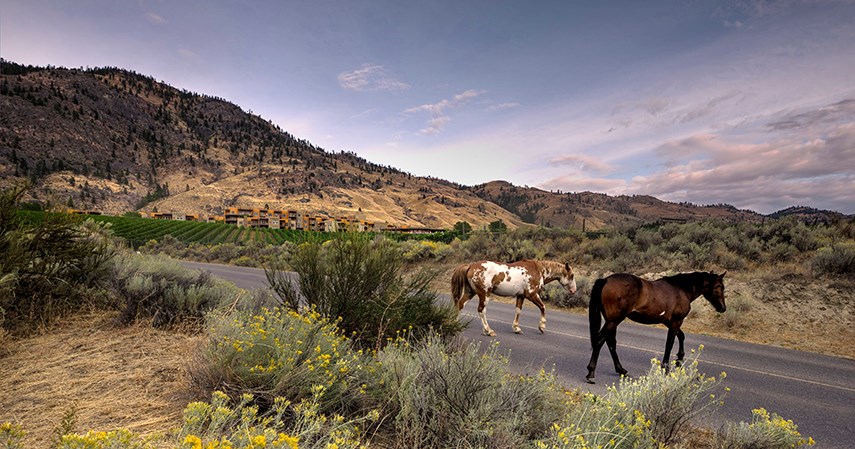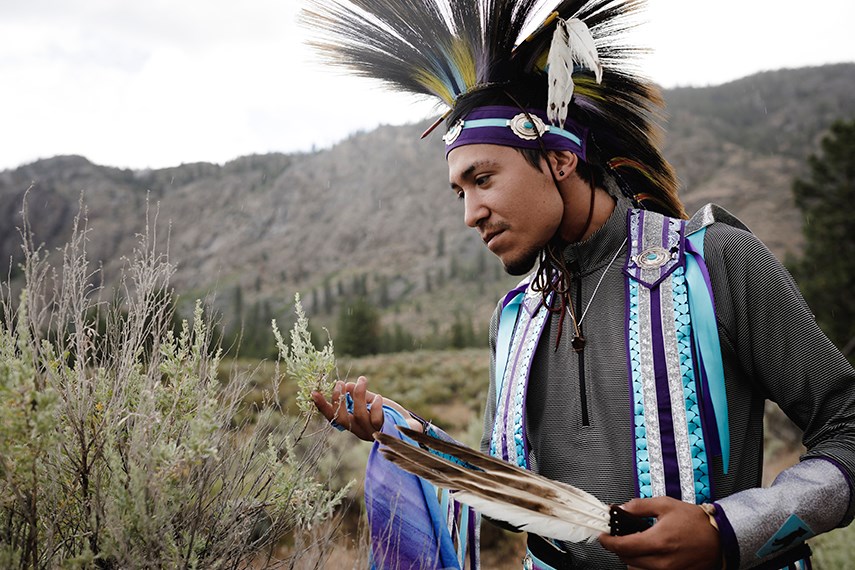On an overcast but warm September morning, Dyawen Louis’ voice echoes over the southern Okanagan Valley,
In the Nsyilxcen language, the interpreter from the Osoyoos Indian Band’s Nk’Mip Desert Cultural Centre sings our tour group a traditional anthem for the Okanagan or syilx people who have lived and travelled across B.C’s Interior for thousands of years.
Translated, the words are “We are beautiful. We are Okanagan. It is because of our land.”
According to Indigenous Tourism B.C., visitors spend roughly $705 million per year on Aboriginal-owned tourism businesses. The Osoyoos Indian Band has been one of the leaders in the field, having opened the first Indigenous-owned winery in Canada. In addition to the wildly popular NK’MIP Cellars, the band also hosts the Spirit Ridge Resort and Sonora Dunes golf course on their reserve land overlooking their vineyards and Osoyoos Lake.
No one needs to be told about the appeal of the south Okanagan in the summer months when tourists flock to the lakeside town but the band is hoping more visitors in the shoulder season will come to appreciate the land and the sites the Osoyoos people hold sacred. It was at their invitation, along with Destination BC, Destination Osoyoos, and the Oliver Tourism association that we’ve come to learn.
Louis tells us the Okanagan people’s creation story, which also sets out a theme for the day.
Before the arrival of humans, the earth was populated by animal and plant beings led by their own chiefs. To prepare for the arrival of meek and defenceless people, the Bear, Bitterroot, Chinook Salmon and Saskatoon Berry food chiefs each sacrificed part of themselves to aid in the people’s survival.
As we travel the territory, a theme begins to emerge, visiting the places where Osoyoos people have gone to fish, hunt and forage, including the picturesque rapids that the town of Okanagan Falls is named after.
Every year, Okanagan Nation members converge there during the salmon returns still practice traditional fishing methods.
“We’ve had tourists come up and they went to Walmart and bought fishing rods and they’re ready to go fishing. But it is a sacred landmark for the Okanagan Nation. Salmon is one of our food chiefs. It’s our most abundant food source,” said Taylor Baptiste, our host for the tour.

It was at the band’s request that Okanagan Falls Park was renamed sx̌ʷəx̌ʷnitkʷ (s-wuh-wuneet-kw), which means little falls, because they want visitors to know how important a place it is, Baptiste said.
“It’s creating the knowledge and understanding among non-Okanagan people that live here or visit here – to know the culture of the land they are visiting because so much of it has been colonized. It’s reclaiming those areas.”
We’re then invited to the sprawling and beautiful sage flats on Osoyoos reservation land to practice bow hunting. Baptiste is internationally ranked in archery in the North American Indigenous Games, though she mostly now focuses on coaching. They set up a foam bear target and we take turns firing arrows at it. If my family were relying on me to bring them home sustenance that day, it would be hard luck because all managed to hit was a sage bush.
Osoyoos people still come here annually to harvest bitterroot, another of the food chiefs.
Horses graze just a stone’s throw away. They belong to a local rancher but wild horses also come and go as they please, Baptiste said.
Exploring band lands isn’t something visitors should do on their own but sẁiẁs Spirit Tours offers cultural excursions specifically for people visiting to better get to know the Osoyoos people.
It’s also why the band developed Nk’Mip Desert Cultural Centre. Inside a beautiful rammed earth building, there are films and interactive exhibits that tell the Osoyoos people’s story. Of particular interest to me was the Inkameep Day School, which the band created so their children wouldn’t have to be taken to residential schools hundreds of kilometres away. For a time, the two-room school house was led by a progressive teacher who encouraged the children to celebrate their culture by creating art, which they excelled at. Later teachers weren’t so progressive and the school burned down in the 1950s, meaning Osoyoos children were once again sent to residential schools.
Today, much collection of art is housed in the Desert Culture Centre and at a temporary exhibit at the Museum of Vancouver. Others still are on the walls of band members’ homes and at least on piece, a buckskin painting by Baptiste’s grandfather, was purchased by the Queen and is on display at Buckingham Palace.
Our stay is at the stunning yet eminently comfortable Spirit Ridge. The restaurant inside takes its name directly from the creation story. The Bear, The Fish, The Root & The Berry is led by executive chef Murray McDonald and executive pastry chef Tammy Maki, both of whom draw on their Indigenous background to inspire their dishes.
I was nursing a nasty sore throat but I swore off my pack-a-day Fisherman’s Friends habit hours earlier out of respect for the chefs and because I want to taste what they’ve put some much effort into creating.
Our meal consisted of three kinds of bannock, scallop, beetroot, bison and berries, all of which McDonald selected for their hyper-local and Indigenous roots, but prepared in a modern fashion. Delicious.

“Farm to table. That’s the original Indigenous food,” McDonald said proudly. “All the superfoods – we did them first.”
Each of the meal courses was strategically paired with NK’MIP wines selected by winemaker and Osoyoos Indian Band member Justin Hall, North America’s first Indigenous winemaker.
Seeing crippling poverty and Osoyoos parents forced to leave and do migrant agriculture labour, the band’s leadership planted their first vineyard in 1968 and struck a handshake agreement with Andrew Peller of Peller Estates. They were “cheap plonk grapes,” Hall said, but sees it as a turning point in the band’s trajectory, one where countless business partnerships and success stories sprang from.
“People come from all over the world now. When I was a kid, it wasn’t that way,” he said.
Other must-see locations of cultural importance to the Okanagan people: Kłlilx’w, also known as Spotted Lake, just west of Osoyoos on the Crowsnest Highway, a pool with circular mineral deposits believed to offer healing; Sẁiẁs, a 38-hectrare provincial park and campground formerly known as Haynes Point, on a naturally occurring causeway that cuts across the southern portion of Osoyoos Lake; and nʕaylintn) formerly known as ‘McIntyre Bluff’, is a popular hiking trail to the top of a 265-metre bluff overlooking the Okanagan Valley.
The Osoyoos Indian Band's website can be found at: http://fall.oib.ca/



